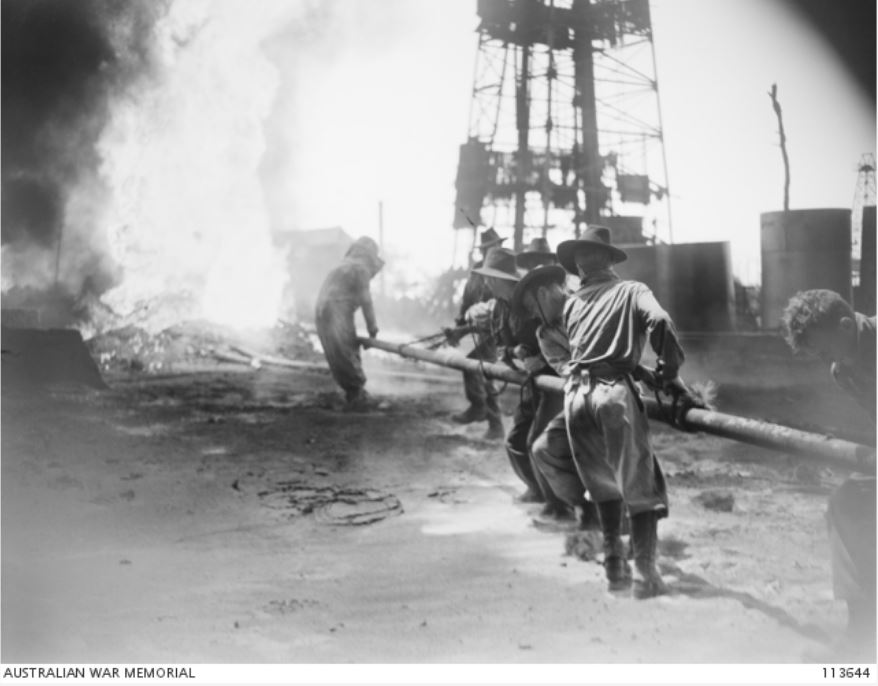Difference between revisions of "2/3rd Australian Field Company"
From Our Contribution
(→Notes) |
|||
| Line 5: | Line 5: | ||
| subheader = | | subheader = | ||
| − | | image = [[File:]] | + | | image = [[File:3rd Field Company Libya.jpg]] |
| − | | caption = | + | | caption = AWM photo 113644 |
| − | | image2 = | + | | image2 = [[File:3rd Field Company Borneo.jpg]] |
| − | | caption2 = | + | | caption2 = 1 Aug 1945. Seria, Borneo. The oil well at Seria were set afire by the Japanese three days before the Australian landing. The extinguishing of these fires was carried out by members of 3 Platoon. AWM photo 113644 |
}} | }} | ||
Revision as of 02:07, 8 January 2021
|
File:3rd Field Company Libya.jpg AWM photo 113644 | |
 1 Aug 1945. Seria, Borneo. The oil well at Seria were set afire by the Japanese three days before the Australian landing. The extinguishing of these fires was carried out by members of 3 Platoon. AWM photo 113644 |
Brief History
Formed in December 1939 at Raymond Terrace in New South Wales it was attached to the 18th Infantry Brigade Group. In January 1940 they moved to Ingleburn, before embarking on the '3rd Convoy' for the Middle East in May. However, with the Italians entering the war, the convoy was deviated to the UK via Cape Town, arriving at Bulford, Wiltshire in June. While training with their brigade, they also constructed defensive positions on the Salisbury Plain. In October they moved to Colchester in Essex, before leaving for the Middle East in November.
Arriving in the Middle East in December, the 2/3rd Australian Field Company went first to Amiriya in Egypt, before moving to follow the advance into Libya in January 1941, first to Tobruk, and then El Agheila in February and then to Marsa Berga. When the Germans began their advance the 2/3rd Australian Field Company were involved with demolitions to cover the withdrawal of the 20th Australian Infantry Brigade into Tobruk. During the siege of Tobruk the company carried out mine work, defensive position construction and water supply in both forward and rear areas. Relieved in October they reassembled at Beit Jirja in Palestine before moving to Qastina camp in November.
Their next move was to Damascus in Syria until January 1942 before moving to Tripoli attached to the 20th Australian Infantry Brigade Group. When the 9th Australian Infantry Division was rushed back to Egypt to assist in halting the German advance during June the 2/3rd Australian Field Company went with them, and in July/August they participated in the confused defensive battles near El Alamein. The also participated in the successful break out from El Alamein in October/November with their primary role being the laying and retrieving, or clearing of minefields. In November they were withdrawn to Beit Jirja in Palestine to prepare for their return to Australia in January 1943. Following leave the unit reassembled at Wallgrove in New South Wales before moving to Keira in north Queensland where they began to prepare for tropical service.
In August 1943 the unit moved to Milne Bay in new Guinea to prepare for a landing at Lae in September attached to the 20th Brigade Group. Following the landing they were tasked with developing the base area, and following the capture of Lae they were support the landing at Scarlet Beach as part of the attack on Finschhafen. With the capture of Finschhafen they worked on the base area before supporting the advance to Sio. In February 1944 they were relieved and moved back to Ravenshoe on the Atherton Tableland to rebuild and await a role north of New Guinea. In April 1945 the 2/3rd Australian Field Company moved to the staging area on Morotai and then landed on the Brunei mainland near Brooketon in June. From here they were dispersed through Brunei and Sarawak with platoons of the 2/3rd Australian Field Company attached to each infantry battalion of the 20th Australian Infantry Brigade. After early advances they were instrumental in rebuilding infrastructure and in assisting the extinguishing of oil well fires at Seria and their restoration as an operating oilfield until the end of the war. Forty six men died while posted to this unit, eight of them due to illness, two from accidents, one from self inflicted wounds, one who was murdered, and 34 who were either Killed in action or who died of wounds received in action.
Unit Personnel
- Alfred George Playle 3 Apr 1940 - 28 Jan 1943
Individual Honours
- 1 x Member of the Order of the British Empire
- 1 x British Empire Medal
- 1 x Military Cross
- 2 x Military medal
- 9 x Mentioned in Despatches
Notes
The Western Australian sappers in the original 3rd Section had left for the Middle East on an earlier convoy, and when the rest were diverted to the UK, they were absorbed into other units.
Content has come from The Unit Guide - Volume 3 - The Australian Army 1939-1945, pages 3.465 & 3.466 - Graham R McKenzie-Smith - Big Sky Publishing - 2018